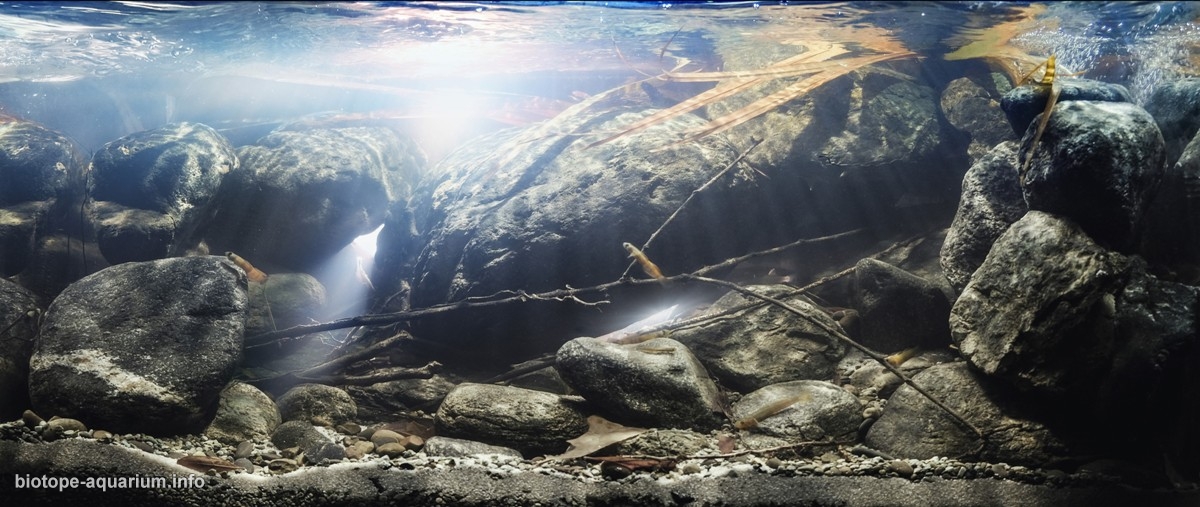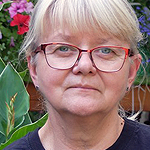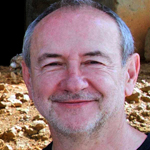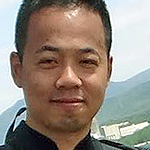Fast flowing stream above waterfall, Lagu Lagu creek, Leyte island, Philippines
2nd place in Biotope Aquarium Design Contest 2019
China. Qi Yin

Volume: 180 L
Dimensions: 90x50x40cm
List of fishes: Sicyopterus lagocephalus (Pallas, 1770), Sicyopus zosterophorus (Bleeker, 1856), Stiphodon surrufus (Watson & Kottelat, 1995), Lentipes sp.
List of plants: There are no aquatic plants except for the plants that are submerged during the rainy season.
Description of decorations: The pebbles, rocks and sands were all collected in the river. The shape and color of the selected pebbles, rocks and sands are basically the same as the habitat. At the same time, some fallen leaves and branches were found at the bottom of the river. After a certain treatment and disinfection, they were used in my aquarium. As a wild-exploration enthusiast, I often snorkel in the stream to observe underwater creatures when collecting in the wild. There was a scene that made me remember. When I snorkel in the stream and explored the trail of creatures near the huge pebbles at the bottom of the riverbed, I suddenly looked up and saw the sunlight coming through the gap behind the huge pebbles. I was touched at this moment. This time, I decide to restore this partial real scene in the stream that I remember.
Description of equipment: EHEIM compact+ 3000 pump (3000L/h). Kessil 360x Tuna Sun 90w (6000k-9000K color spectrum). Laoyujiang CX-W3 55w Natural Wave Pump (20000L/h). The color spectrum of Kessil 360x Tuna Sun spotlight is closer to the sun. The shining light can more prominently show the relationship between the ripples of the water surface and the underwater objects. I carefully designed an annular water flow system for these fast-flowing stream fishes. The bottom of the aquarium is vacuum. A natural wave pump is placed on the one side of the bottom. Under the thrust of the wave pump, the water flows out from the other side of the bottom of the aquarium and enters the top of the tank, returning to the starting point under the action of the water flow, which forms a water circulation inside the cylinder. Since, the flow rate in the tank is very fast, just like the habitat I described, these gobies can live in my aquarium in the same way as they do in the nature.
Water parameters: The aquarium is placed in my studio. The temperature of the water is about 24 ℃. PH=7.2 and GH=7.
Additional info: No
INFORMATION ABOUT BIOTOPE
Description of the area surrounding the biotope: Lagu Lagu creek is located in Leyte island. Leyte island is in the Visayas group of islands in the Philippines. It is the seventh largest island in the Philippines by land area. The coordinates is 10°50′ N, 124°50’E. The island measures about 180 kilometres north-south and about 65 kilometres at its widest point. The highest elevation is 1,348 m and the highest point is Alto Peak. In the north it nearly joins the island of Samar, separated by the San Juanico Strait, which becomes as narrow as 2 kilometres (1.2 mi) in some places. The island province of Biliran is also to the north of Leyte and is joined to Leyte island by a bridge across the narrow Biliran Strait. To the south, Leyte is separated from Mindanao by the Surigao Strait. To the east, Leyte is somewhat “set back” from the Philippine Sea of the Pacific Ocean, Samar to the northeast and the Dinagat Islands to the southeast forming the Leyte Gulf. To the west is the Camotes Sea. Leyte is mostly heavily forested and mountainous, but the Leyte Valley in the northeast has much agriculture. There are some waterfalls on the hills of the island, and the streams of the waterfall will eventually flow into the sea. Most inhabitants are farmers. Fishing is a supplementary activity. Rice and corn (maize) are the main food crops; cash crops include coconuts, abaca, tobacco, bananas, and sugarcane. There are some manganese deposits, and sandstone and limestone are quarried in the northwest.
Description of the underwater landscape of the biotope: The habitats I described is a clear, fast flowing and oxygen rich stream above waterfall in middle course of Lagu Lagu creek. The substrate of the riverbed is sandy with large pebbles and rocks. As the stream flows through the forest, the bottom of the water is scattered with branches and leaves.
Description of the parameters of the habitat: The Philippines is a tropical island. It has only two seasons: the wet and dry season. The dry season starts in late November and ends in May. The rainy season starts in June and lasts till October. September and October are often the typhoon season in the Philippines. During the rainyseason, the water level of the stream rises and the water temperature drop. The dry season starts from November to May. During the dry season, the water levelin the stream decreased and the water temperature rise. April and May are the hottest months in the Philippines. The sky is at its bluest and the water at its clearest during this time of the year. The water temperature of the stream is between 24 and 30 degrees Celsius. The pH of the water is about 7 and the GH hardness is about 7.
List of fishes and invertebrates occurring in the nature biotope: Sicyopterus lagocephalus (Pallas, 1770)
Sicyopus zosterophorus (Bleeker, 1856)
Stiphodon surrufus (Watson & Kottelat, 1995)
Sicyopus auxilimentus (Watson and Kottelat, 1994)
Lentipes sp.
List of plants found in the nature biotope: There are no aquatic plants except for the plants that are submerged during the rainy season.
Threats to the ecology: When I went to the wild to take photos on these lovely fishes with my friends, some local villagers went to the river to take a bath and used shampoo. I was so distressed to see this. I really hope that these natural scenes will not be vandalized. But I know that there are things I can’t stop, so what I want to do is to demonstrate the most natural waterscape and show the most beautiful side of the little fishes, and let people around me see these most common little creatures. It is very beautiful. I hope that everyone will pay more attention to them in the future. Stop destroying our beautiful native world.
Sources of information:
1.Indo-Pacific Sicydiine Gobies Biodiversity, life traits and conservation, Philippe Keith, Clara Lord, Ken Maeda
2. https://www.withlocals.com/
3. https://mp.weixin.qq.com/s?__
Comments of the members of the jury of Biotope Aquarium Design Contest 2019

I think this is my tank of tanks. The unrivalled aesthetic aside, so much attention has been given to creating individual territories to the goby inhabitants — without once compromising the natural look of the layout — that the aquarist responsible deserves high praise for that alone. You only need to watch the fish to see that they know exactly where they are, and where they are is the Philippines creek they’ve spent so long evolving to inhabit. They have all the space they could want, all the perfect vantage points they could spend a lifetime seeking, and all the creature comforts that aquarium technology can bring. These are lucky fish.

It is another great example of a great projection of the natural habitat. Wonderfully composed biotop of a stony river, excellent light in the water. You can see that the fish behave like in the wild. All details this setup are very precisely arranged but looks very natural. Congratulation to author.

That’s indeed how fast flowing waters are looking like – stones, wood, not very much fine substrate. A great composition and setting, with the right species in.

In fact, it is an exclusive aquarium with several species of gobies. I have no doubt that the author of the work scrupulously studied this biotope in nature. Oh, Macrobrachium shrimps still could have been added.

It is an incredible work. The arrangement of the rocks and the play of light give us a fairly real impression of what we can observe in nature in this type of biotopes. The root stuck between the rocks and the leaves entering the water complement the scene. Congratulations, well done!

I am really convinced that you “breathe” this stream and know every single detail of your work. Very nice light effects. The combination of the pebbles, rocks and sand feels very natural. Good job!

Sicydiine fishes, especially Sicyopus and Lentipes, usually live in upper streams from rocky area. The participant observed the habitat carefully, and simulated the nature well in this tank. The big stones provided lots of essential spaces for Sicydiine fishes.

Such a scene is often seen around the actual waterfall. This biotope aquarium not only faithfully reproduces the state of the local area, but also has a wonderful artistry as a work. The directing of light from the surface of the water makes us imagine the intense sunlight. The fish use some rock gaps to protect themselves from the sunlight. It is a great work that makes us feel such a natural life.
